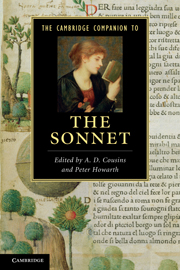Book contents
- Frontmatter
- Introduction
- 1 Contemporary poets and the sonnet
- 2 The sonnet and the lyric mode
- 3 The sonnet, subjectivity and gender
- 4 The English sonnet in manuscript, print and mass media
- 5 European beginnings and transmissions
- 6 Desire, discontent, parody
- 7 Shakespeare’s Sonnets
- 8 Sacred desire, forms of belief
- 9 Survival and change: the sonnet from Milton to the Romantics
- 10 The Romantic sonnet
- 11 The Victorian sonnet
- 12 The modern sonnet
- 13 The contemporary sonnet
- Further reading
- Index
2 - The sonnet and the lyric mode
Published online by Cambridge University Press: 28 May 2011
- Frontmatter
- Introduction
- 1 Contemporary poets and the sonnet
- 2 The sonnet and the lyric mode
- 3 The sonnet, subjectivity and gender
- 4 The English sonnet in manuscript, print and mass media
- 5 European beginnings and transmissions
- 6 Desire, discontent, parody
- 7 Shakespeare’s Sonnets
- 8 Sacred desire, forms of belief
- 9 Survival and change: the sonnet from Milton to the Romantics
- 10 The Romantic sonnet
- 11 The Victorian sonnet
- 12 The modern sonnet
- 13 The contemporary sonnet
- Further reading
- Index
Summary
‘Let us inspect the lyre’ (Keats): introduction
At first glance the relationship between the sonnet and lyric seems transparent: if one adopts the common definition of a mode as an overarching and transhistorical category encompassing many genres, surely the sonnet is not merely an instance but also a textbook example, even a prototype, of the lyric mode. Lyric is, for example, often defined in terms of its length, and, according to common though not unchallenged definitions, the sonnet weighs in at fourteen lines; lyric is frequently represented as the genre of internal and individualized emotions, and the principal subject traditionally associated with the sonnet is love; lyric is typically associated with song and music, as is the sonnet. To be sure, many critics have claimed that prototypical status for elegy, maintaining that its emphasis on death and loss renders it a prime example of the preoccupation with absence often attributed to lyric. But the candidacy of that genre for the status of prototype does not preclude and may even support another contender, since the sonnet too often dwells in and on loss, whether it be the death of the lady in the originary sonnets by the Italian poet Francesco Petrarca (Petrarch), her loss in poems by many of his followers, or the permutations on disappearance and absence in numerous later sonnets (‘So help / me God to another dollop of death, / come on strong with the gravy and black-eyed peas’, Rosanna Warren implores in her witty sonnet ‘Necrophiliac’, 2–4).
- Type
- Chapter
- Information
- The Cambridge Companion to the Sonnet , pp. 25 - 45Publisher: Cambridge University PressPrint publication year: 2011
- 2
- Cited by



